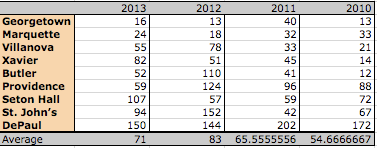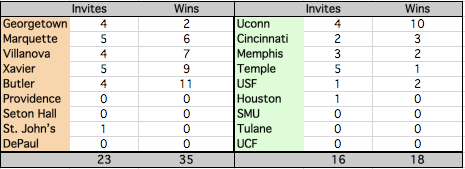As you’ve read from 37 different outlets’ sources, the final demolition of what we will call the old Big East is just about wrapped up. Sure the presidents of the football schools left behind are dragging a bit, but it’s a clear cash grab that should be ironed out by March 5, the day FOX Sports announces the launch of FOX Sports 1 and FOX Sports 2. (For the sake of transparency I should note that I work for FOX Sports Wisconsin, a subsidiary of the FOX Sports brand, but I am not privy to any useful information regarding this subject. Sorry.)
ESPN is reporting that the league will begin this fall and include the Catholic 7 plus Xavier and Butler–with a tenth team still being discussed– and pay member institutions between $3 and 4 million a year from the television contract.
This move has been in the works for a few months now and has been universally lauded by coaches (Rick Pitino) and pundits alike. You know what comes next though, right? Push back .
In this day and age there are too many clicks to be had by taking a contrarian position. Skip Bayless has made too much money simply by going against the consensus no matter how ridiculous it may be.
The prime culprit this afternoon was Mike DeCourcy, a very well respected columnist and reporter at Sporting News and a contributor for the Big Ten Network. I met DeCourcy at the NCAA Tournament in Louisville and can tell you first hand what an amicable and friendly guy he is, talking to this as well as many other lowly bloggers in the media room. I harbor no ill will towards the man, I simply believe he is wildly off course with his assertion that the leftover Big East schools, which he dubs the Metro 9, are “just as strong” as the C7 plus Xavier and Butler.
He states: “Competitively, however, there’s not an enormous difference between the two groups,” then backs that up by noting that the Metro 9 are projected to get three teams –Memphis, Temple and Cincinnati– in the NCAA Tournament this season while the C7+2 only project four –Marquette, Georgetown, Butler, Villanova.
The first bone I have to pick is that it’s much too primitive to only rely on one bracketologist to make definitive assertions about who is and is not in to the Tournament at this point. Had he looked around at other legitimate sources, he’d have seen that St. John’s is still in consideration. Sure, they may sit on the wrong side of the field at the moment, but to not even discuss that is a glaring omission.
Furthermore he fails to mention that all three of the Metro 9 teams are currently on the fence for inclusion. CBS Sports’ Jerry Palm has all three on the bubble. ESPN’s Eamon Brennan places Temple and Cincinnati in the same group (work left to do) as Nova, who DeCourcy badmouths and St. John’s, who he ignores. The same goes for Andy Glockner of SI who says all four teams have work left to do.
That means it is just as conceivable to have the C7+2 get five teams while the Metro 9 only get one. Changes things a bit, doesn’t it.
Alas, it is asinine to judge the overall strength of a conference based on one year’s results of NCAA Tournament invitations. There is a lot more that goes into the strength of a league than just who was one of the best 40 or so teams in the country in a given year.
If you want to rank teams by their relative strength in any particular year, an analytical system that takes human bias out of the equation and is not as outdated as RPI would be ten times more useful. I would go with the KenPom rating system. Although it does have its flaws, (I’m looking at you Wisconsin) it isn’t altered from year to year, which is useful for analysis such as this.
Above is a chart tracking the C7+2’s KenPom ratings the past four years, including this year. Measure that against the Metro 9’s numbers.
As you can see, the C7+2 had a better average rating every season the past four years, with the closest margin being 11.2 spots last season. This season it’s a 42 spot margin while the 2010 average rating was almost 50 worse for the Metro 9. Tallied all up, the C7+2 had an average team ranking of 68.5 the past four years while the Metro 9 came in at 103.1. Some people might say 35 spots is no big deal, but I’m not one of them.
Furthermore, it’s important to not just look at the data from one season because this is college. Players graduate, leave for the NBA and transfer. Even blueblood programs like North Carolina struggle every so often. Just because Butler is more likely to make the tournament this year doesn’t make it a better program than Kentucky, who is still within bubble range. So cherry picking one bracket one week out of one year is about as useful as using the daily weather to demonstratively argue for or against global warming. You have to take a look at the bigger picture.
Still, some might say KenPom is not a good arbiter of success, as having nine mediocre teams would give you fairly positive results, but a league with few if any non-auto bids. They might also be against advanced statistics and want some more basic measurements of success. Let’s look at the tape.
Measuring up win/loss records doesn’t give us much useful information, particularly when seven teams came from a “power” conference with much tougher opposition for the C7+2 compared to two from the Metro 9. You would expect some gaudy numbers from the latter group. So I looked at the past ten years of records (including this year) to get a nice broad scope.
Turns out they are very close. The Metro 9 has a combined 1652-1186 record for a 58.21 winning percentage while the C7+2 has gone 1716-1176 in the past ten years, for a 59.34 winning percentage.
This doesn’t take conference strength into account, let alone that having 77 percent of your league beating up on each other nullifies some victories. Looking at non-conference records would have been the way to go here.
If Mike is going to talk about potential brackets, it makes the most sense to actually look at previous tournament appearances rather than hypothetical future ones. I think a look back at the previous five years is a long enough timeframe to adjust for cyclical ups and downs.
As you can see, there is quite a gap between the two groups, particularly in the Tourney wins column, as the C7+2 have almost twice as many as the Metro 9. (Note: Memphis’ runner up run is not included, as all wins were vacated.)
Maybe you say this isn’t looking back quite far enough, and I am just cheryy picking favorable data. Take a look at the 10 year Tournament comparison.
A bit closer, but there is still a very noticeable gap in both the wins and invites columns.
Just for kicks and giggles I looked up attendance numbers for all 18 teams the past four years. I know this has nothing to do with on court performance, but I figured it would be a decent way to gauge interest which does play a tangential role in the recruiting process he cites. The lowest number for any C7+2 team was Butler’s 5,897 averaged in 2009. In comparison, Tulane averaged 1,733 fans per game in 2010.
For the grand finale: Depaul’s four year attendance average would rank third in the Metro 9 behind only UConn and Memphis. Let that one sink in for a bit.
I love a good argument as much as the next guy, but frankly, Mike DeCourcy’s column had little substance to it. The C7+2 is better than the Metro 9 every way you slice it.






Trackbacks/Pingbacks
[…] went into this a bit last week as a response to a columnist falsely claiming the gap between the new Big East and the […]
[…] already published a few analyses of past KenPom ratings that show the Big East will still be a major power player. In no way was it a knock on the play on the court, but rather in the board room of FS1. Yes, they […]
[…] case you missed it, I had a bit of an infatuation with the AAC v. Big East storyline a few months back, or Metro 9 v C7 as I called it before we knew […]